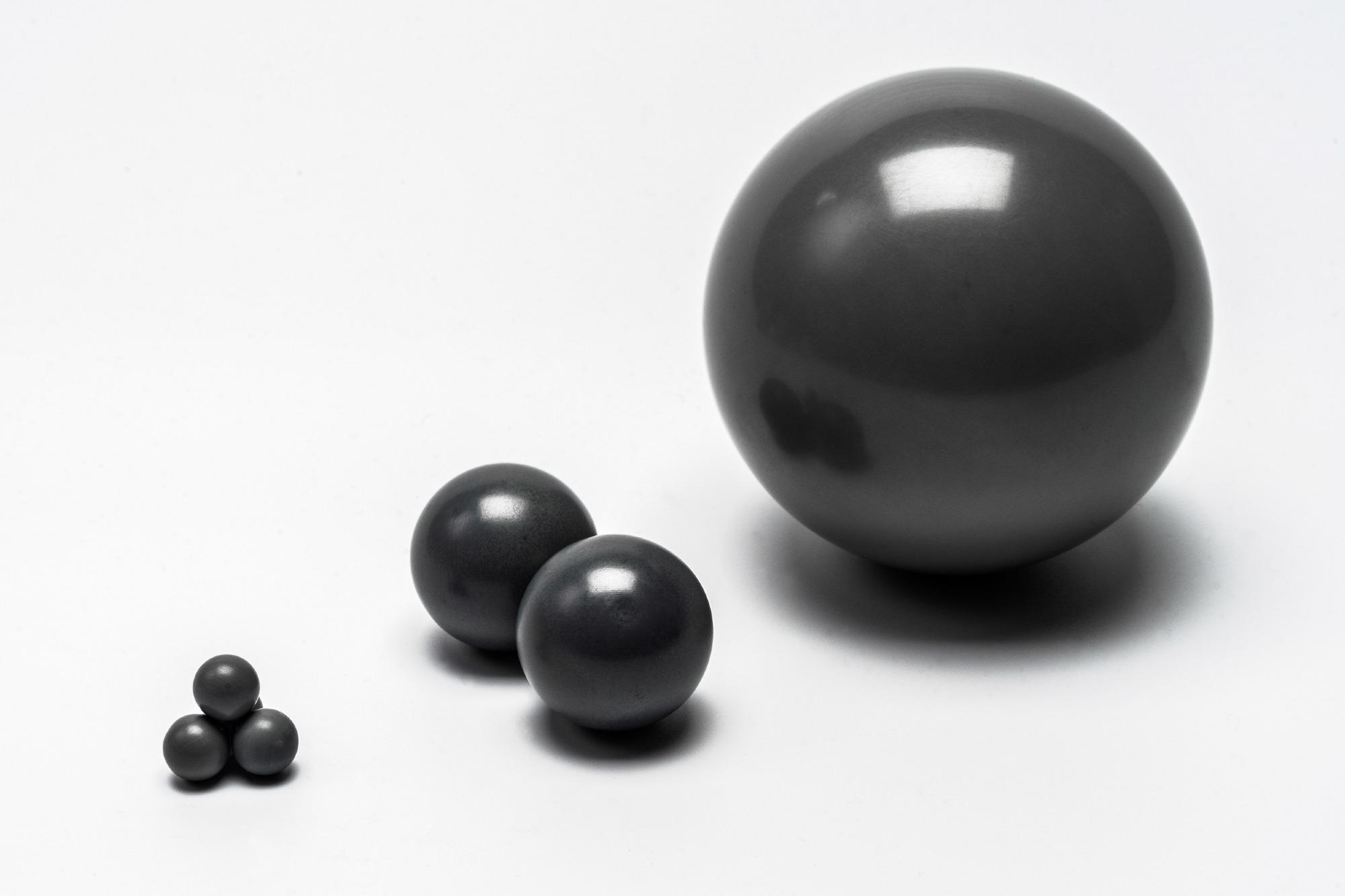The laboratory grinding of course abrasive substances for the preparation of homogeneous powder samples or for particle size reduction purposes is important in fields of research such as ceramics, glass, metallurgy, pharmaceuticals and geology. An established method for doing this is by using high energy planetary mills.

Image Credits: International Syalons
These mills consist of a bowl and cover containing a number of grinding balls. The sample is ground (either wet or dry) through impact and friction of the balls with each other and with the inside surface of the bowl. As a result of the high energy of the balls (they can reach a centrifugal force of approximately 20 times gravitational acceleration) there is a severe burden put on the grinding media, particularly when grinding very hard abrasive substances. Thus, in order to limit contamination (which for many applications is very important) the grinding media should possess certain fundamental properties. These are high hardness coupled with excellent wear resistance (to limit contamination through abrasion), chemical inertness (to avoid a chemical reaction between the grinding media and the sample) and high purity. These requirements have restricted the number of candidate materials suitable for this application. They include agate (a naturally occurring form of silica), zirconia, alumina, tungsten carbide and hardened steel.
The majority of grinding materials used are ceramic, which as a class of materials are generally characterized by their high hardness and chemical inertness. They have the added advantage that they are free from significant amounts of metallic impurities, which is often an important consideration when preparing a sample for chemical analysis. A recently developed ceramic, Syalon 101, also has these highly desirable properties but coupled with its proven success in other applications demanding wear resistance, it is a material worthy of consideration as a high energy grinding material.
Aims
The purpose of this investigation was to compare the wear resistance and grinding efficiency of Syalon 101 to conventional materials used as grinding media for the high energy grinding of abrasive substances. The materials chosen for comparison were agate, zirconia (ZrO2) and tungsten carbide (WC). These materials, along with Syalon 101, cover a wide range of physical properties. It is hoped that some deductions may be able to be made as to which material properties are important for optimum high energy grinding.
Experimental
The grinding experiments were performed on the Fritsch “Pulverisette 5” (P5) Laboratory Planetary Mill and the Fritsch “Pulverisette 7” (P7) Planetary Micro Mill. Experiments on the P5 were done using Syalon 101, agate and zirconia grinding media, while those on the P7 were done using Syalon 101 and tungsten carbide media.
To compare the wear resistance of the four chosen grinding media materials, the weight loss of the grinding bowls, the bowl covers and the grinding balls were measured after the wet (in water) grinding of three abrasive samples for up to 1 hour. The samples chosen were a coarse beta-silicon carbide (SiC), a sintered crushed alumina (Al2O3) and a basalt stone. Of particular note is the extreme hardness of these materials which will severely test the grinding media materials. The weight losses were measured at time intervals of 5, 15, 30 and 60 minutes. At the same time, an indication of grinding efficiency was determined by measuring the particle size of the samples after each tome interval, beginning with 15 minutes.
The two configurations of balls used with the P5 were chosen to study the affect of ball size on wear resistance and grinding efficiency. Each combination of experimental configuration and grinding media material was used for each of three grinding samples. The particle size measurements were done using the Fritsch “Analysette 22” Laser Particle Sizer.
Results
Grinding Tests on the “Pulverisette 5”
For comparative purposes the results for the weight losses from the grinding balls will be used since they are the greatest and therefore the most accurate. However, it can be seen that the weight losses for the bowls and covers generally follow the same pattern. It is immediately obvious that in all cases the weight losses from the Syalon 101 grinding media are significantly less than those for zirconia and agate. For example, after 1 hour grinding of SiC the 20mm diameter Syalon 101 balls lost 2.52g compared to 14.57g for zirconia and 14.37g for the agate. Thus Syalon 101 is nearly 6 times more wear resistant than both the zirconia and agate. Indeed, this pattern is repeated throughout with Syalon 101 typically being between 5 and 10 times more wear resistant, although in certain cases when grinding the less hard alumina and basalt samples the wear resistance is much greater than this.
The weight losses for all the media materials relative to time are generally greatest in the early stages of milling, i.e. the first 15 minutes of milling. For example, milling SiC using configuration 1, approximately 50% of the total weight loss occurs in the first 15 minutes. This can be explained by the fact that there is more abrasion involved in crushing the initially coarse materials.
The two ball sizes suffer from relatively similar amounts of abrasion, with the 20mm balls generally giving slightly more pick-up as a result of the greater number of collisions taking place.
The results of the particle size measurements show the influence of grinding ball density on milling efficiency. In all cases, the heavier the media the finer they grind in a given time. For example, the d50 values (that is the particle size of the 50% undersize) for SiC milled for 30 minutes using 20mm balls with zirconia and Syalon 101 (Figure 3) are 8.08µm and 13.16µm respectively. This is due to the heavier balls having greater impact energy. It can also be seen that the effect of media density is more pronounced the harder the sample being ground.
The effect of milling ball size on milling efficiency can also be seen. For example, the d90 values for the SiC milled for 30 minutes using 20mm and 30mm Syalon 101 balls are 35.03µm and 47.25µm respectively. It should be noted however, that when crushing initially very coarse materials, for example the sintered alumina, for the 20mm balls it took 30 minutes before the sample was ground sufficiently such that a particle size measurement could be made, whereas with the 30mm balls this could be done within 15 minutes. This was true for all the media materials.
Grinding Tests on the “Pulverisette 7”
As with the results for the “Pulverisette 5” the Syalon 101 grinding media show significantly less wear than the tungsten carbide (WC). Typically, the Syalon shows between 5 and 15 times less weight loss than the WC.
The WC is more effective than Syalon 101 when grinding very hard samples such as silicon carbide, although for the longer milling times (i.e. 60 minutes) the particle size distributions are almost identical.
It should be noted that the Syalon 101 media would not grind the sintered alumina sample. In this small mill with just 15mm balls the Syalon did not have enough energy to crush the very hard, large lumps.
When grinding a relatively soft material like basalt the Syalon 101 was more effective than WC. For example, for 60 minutes milling the Syalon resulted in d50 of 2.76µm compared to 3.47µm for the WC. This is contrary to what we have seen for the heavier grinding media in the other trials and is thought to be a re-sintering effect due to the intense impact forces on the soft basalt from the high energy WC balls. Thus, WC would not be recommended for grinding softer materials, particularly for longer grinding times.
Summary and Conclusions
Measuring and comparing the weight loss of several grinding media materials after grinding an abrasive sample is a simple but effective method for ranking the materials with respect to their abrasion resistance. Also, by measuring the particle size distribution of the samples after grinding, an appreciation of the grinding efficiency could be gauged. These methods were used to compare Syalon 101, zirconia, agate and tungsten carbide grinding media.
It has been shown that for all the experimental conditions studied, Syalon 101 shows much greater wear resistance than the other three materials, and was typically between 5 and 10 times better, with the advantages of Syalon being more evident for lower harness samples.
The grinding efficiency has been found to depend several things. Firstly, the greater the density of the media (and hence the weight of the grinding balls) the finer the sample is ground in a given time. This is a result of the heavier balls having greater impact energy. However, if a relatively coarse sample is required (i.e. greater than 30µm), the lighter media materials (Syalon 101 and agate) perform as well as the heavier materials. The effect of the density is also reduced for the softer samples. In fact, it was observed that when a very heavy media (WC) was used for a relatively soft sample (basalt), the particle size can actually increase as a result of a resintering process.
It was hoped that by relating these results to the physical properties of the grinding media materials, the properties of importance of optimum high energy grinding would be identified. However, there was no real pattern observed, particularly with regard to wear resistance. For example, although Syalon zirconia and WC all have very similar hardness values, the Syalon 101 shows significantly better wear resistance. Also, although agate is much less hard it shows very similar wear resistance to zirconia. With respect to grinding efficiency, it can be concluded that higher density media are more effective, particularly for short milling times and for very hard samples. However, this is at the expense of greater contamination.
Overall, we conclude that Syalon 101 possesses the best combination of abrasion resistance and grinding efficiency. Although longer milling times may be required to achieve the desired particle size, this is offset by substantially reduced wear.

This information has been sourced, reviewed and adapted from materials provided by Internatrional Syalons.
For more information on this source, please visit International Syalons.